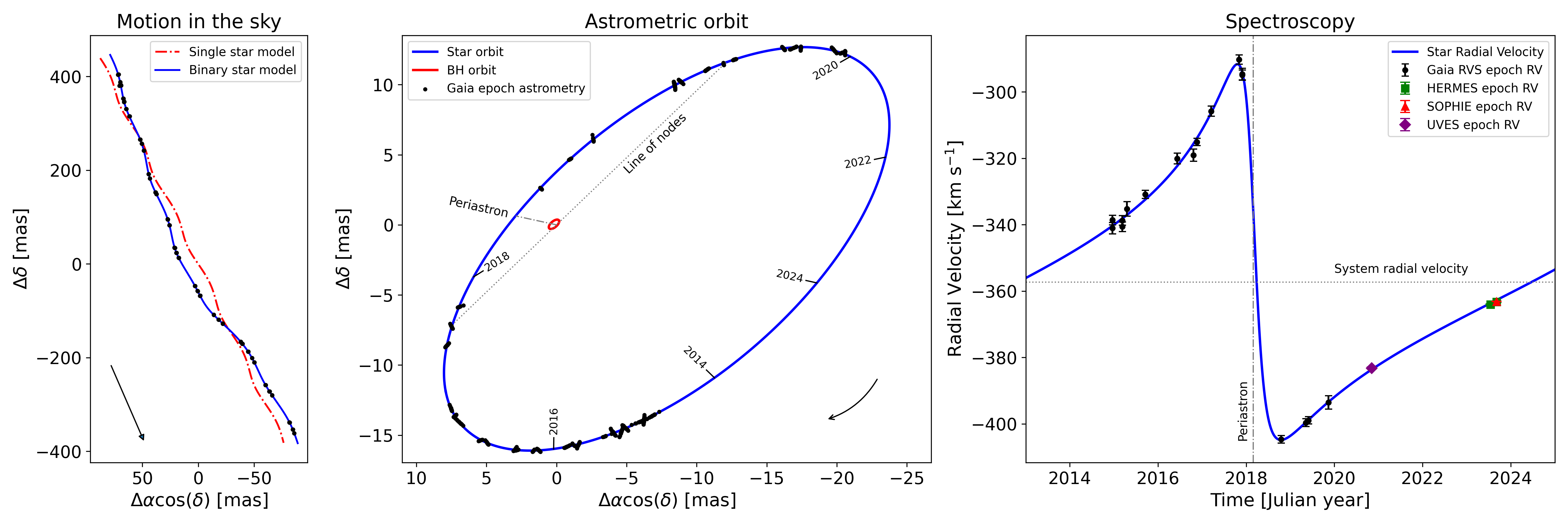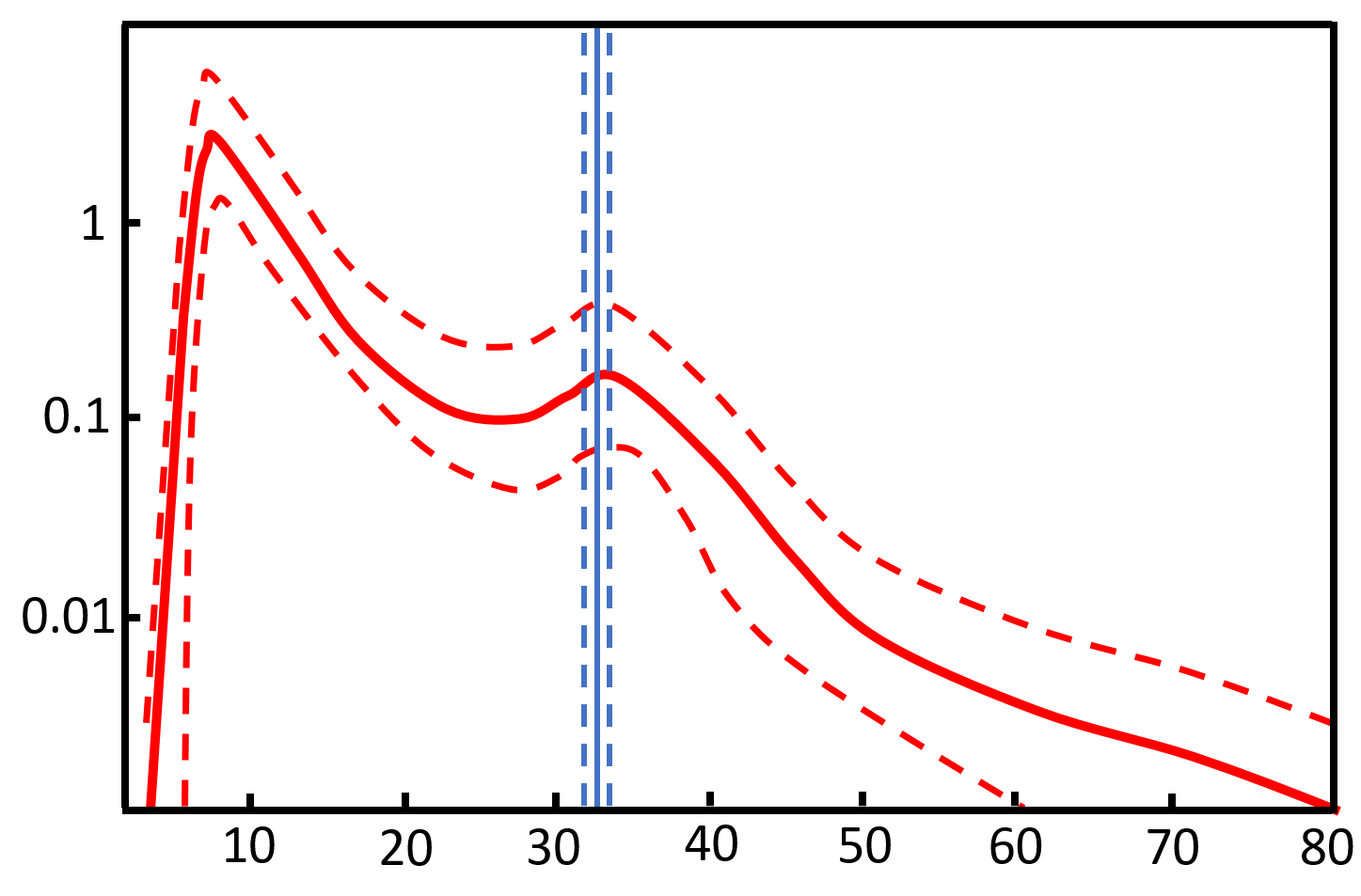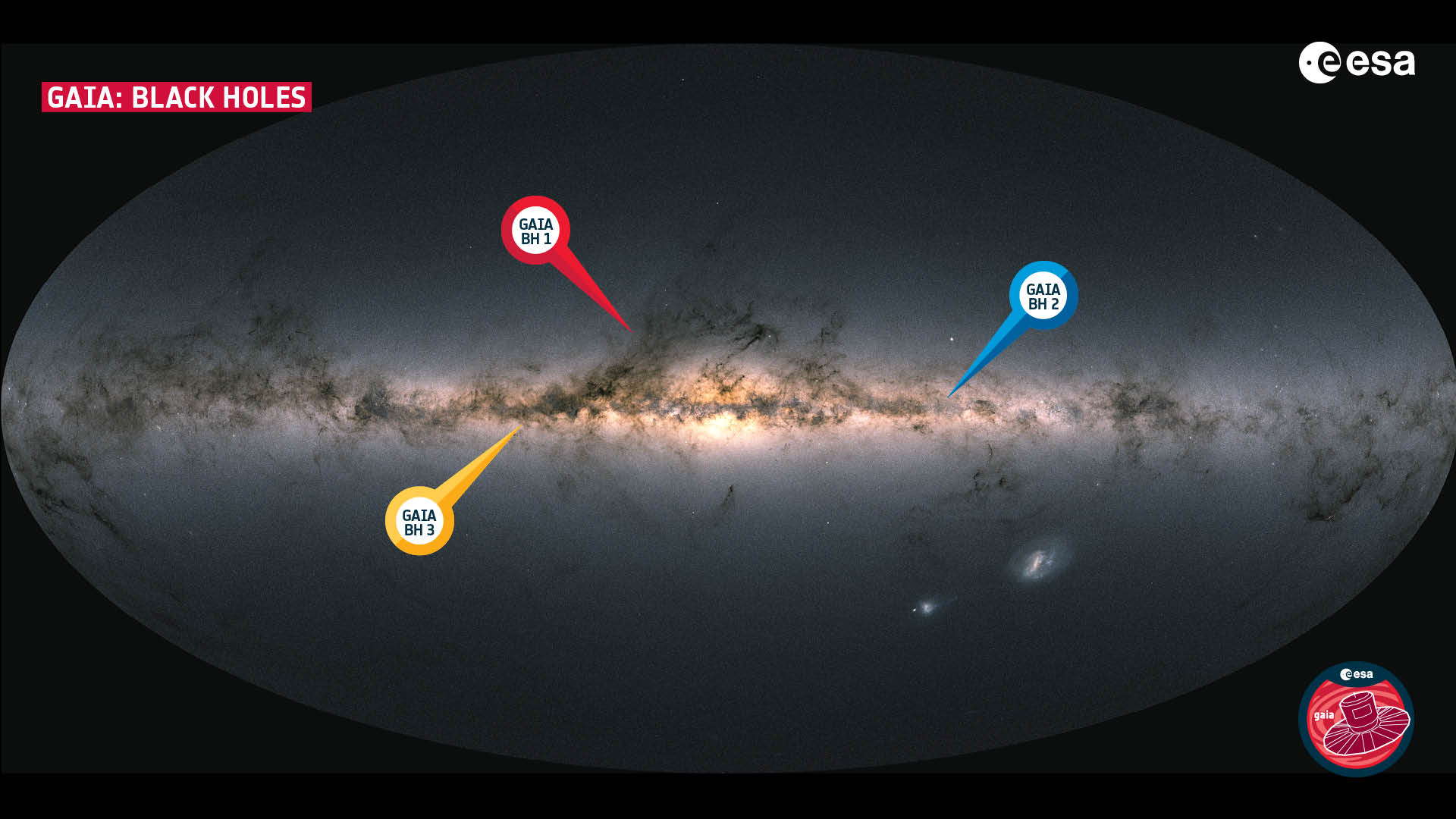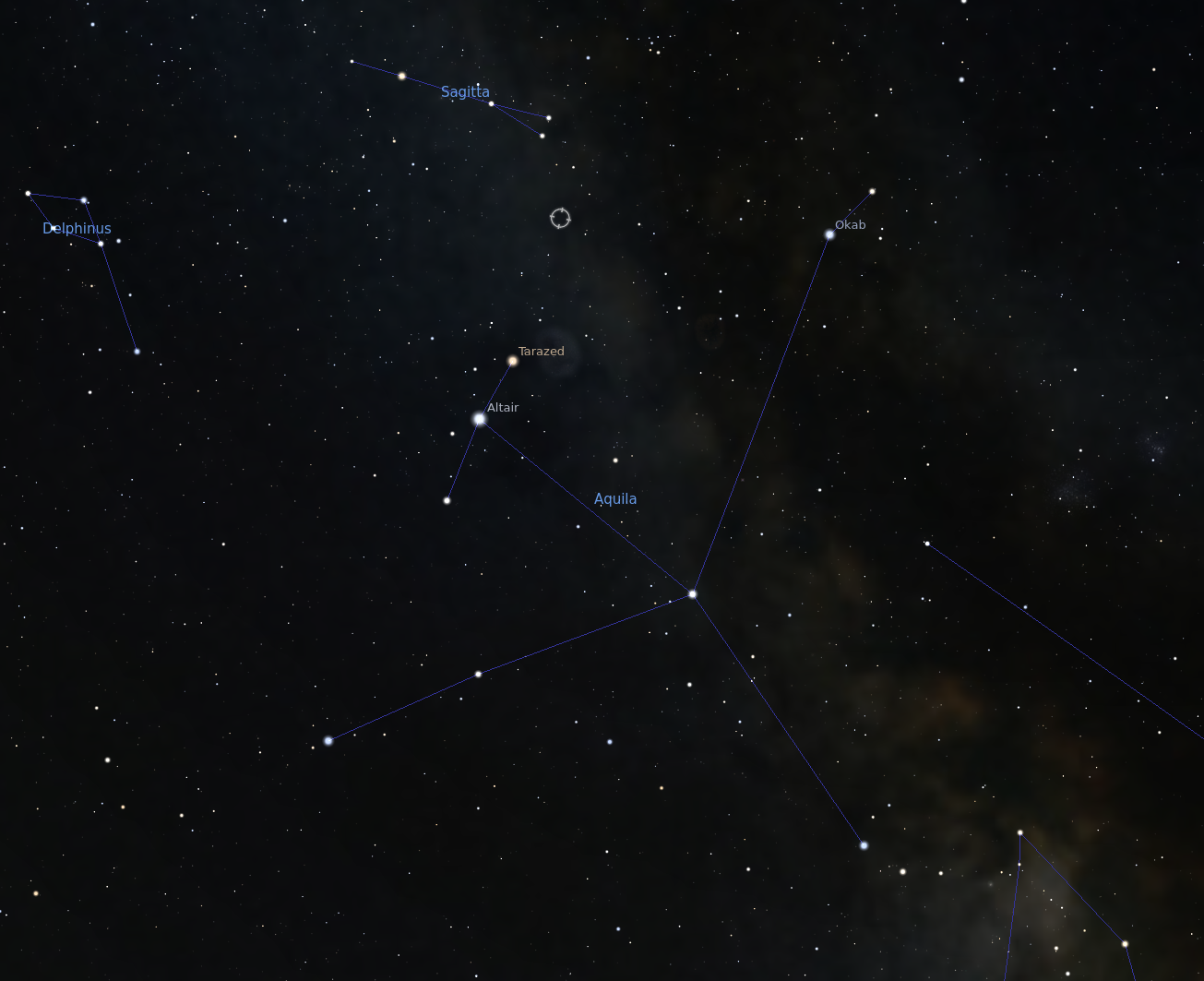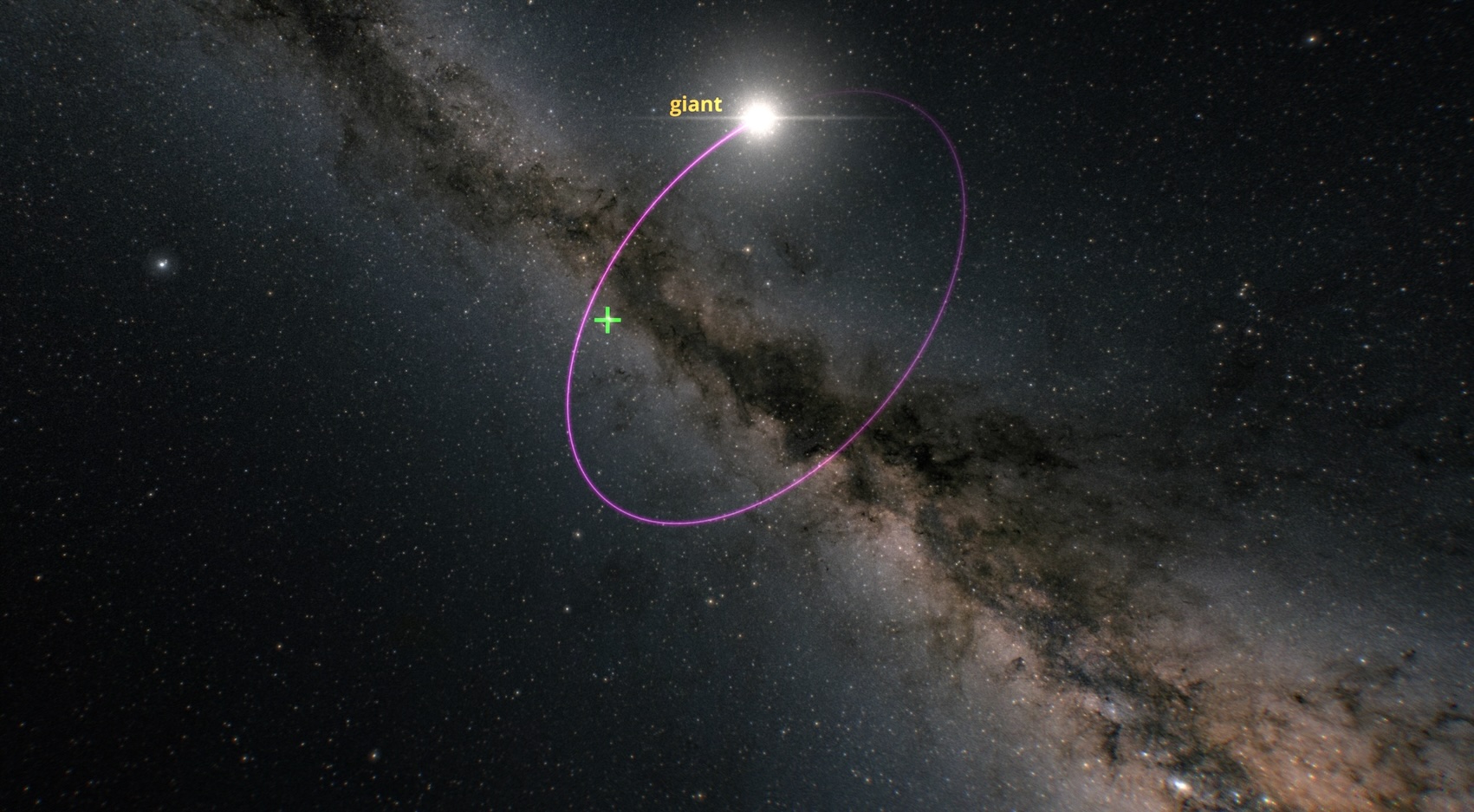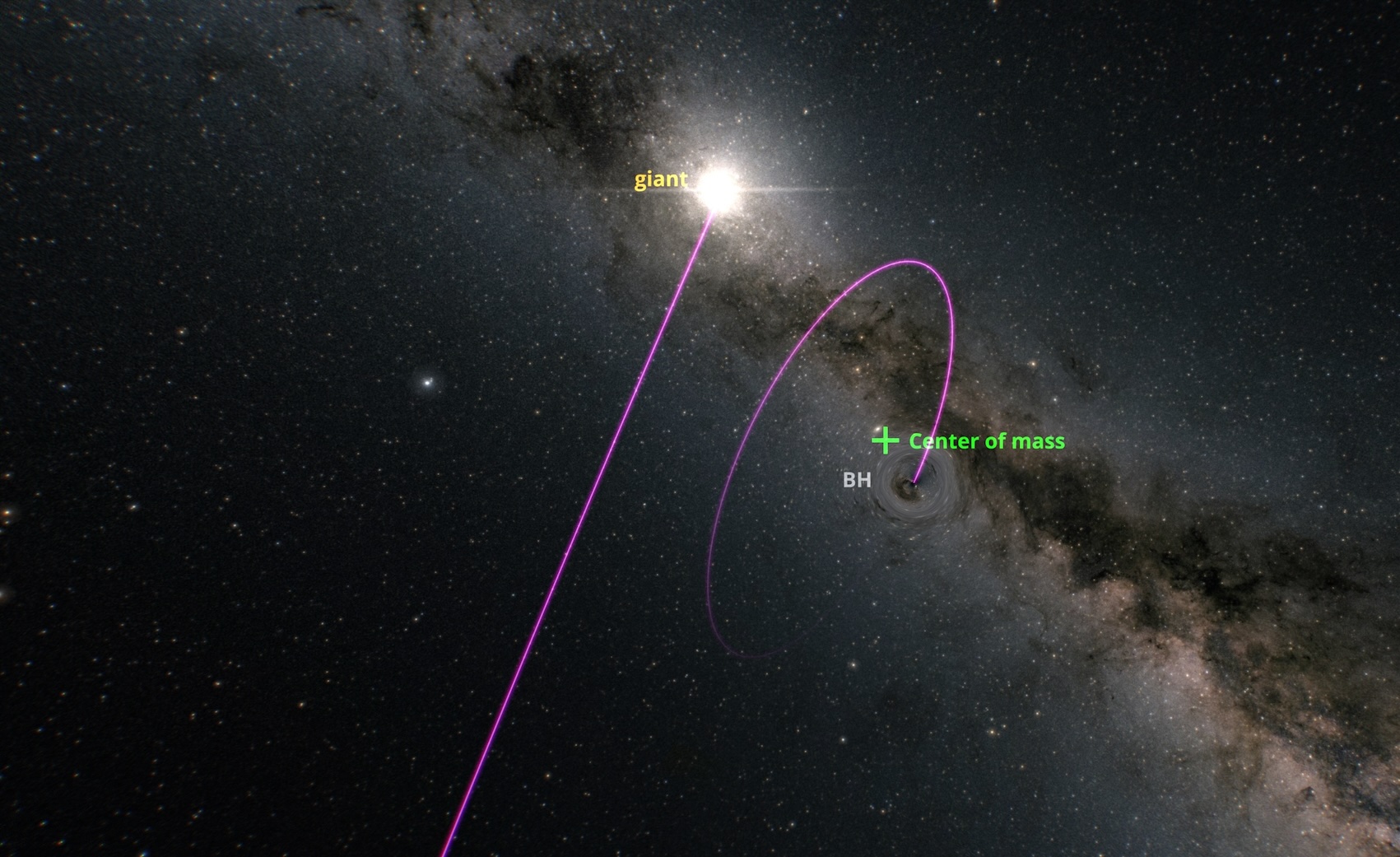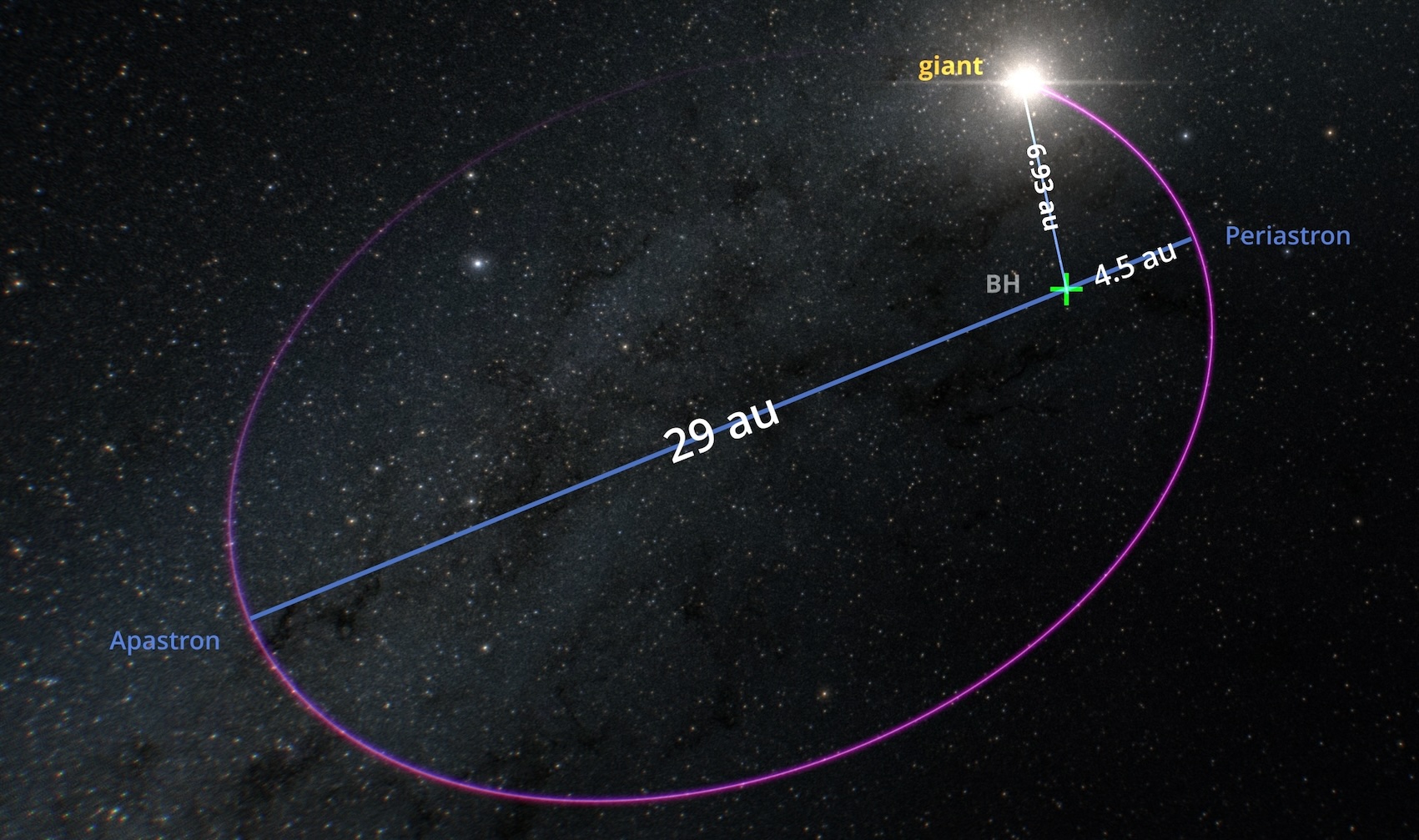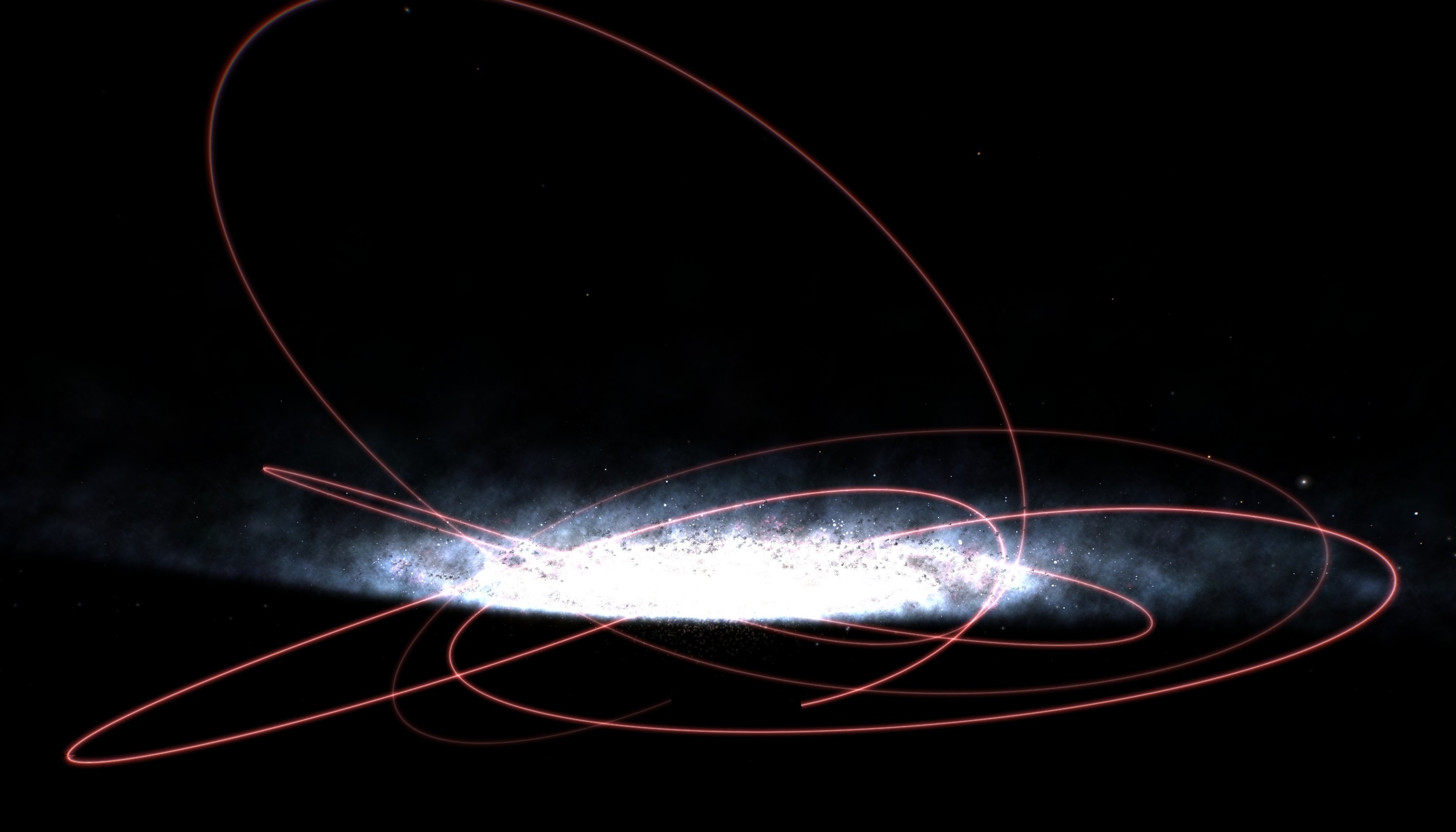Gaia Image of the Week - Gaia
Image of the Week
Gaia spots Milky Way's most massive black hole of stellar origin
A view of Gaia BH3 and its companion star, with the system's motion on the sky (on the left), their orbits as projected on the sky (in the middle), and the evolution of the radial velocity of the companion star (on the right). Gaia's observations, both astrometry (left and middle) and spectroscopy (right) were taken between 25 July 2014 and 20 January 2020, making a total time span of 5.5 years of observations. The same time span on which Gaia Data Release 4 will be based. The spectroscopic view also shows ground-based radial velocities taken in November 2020 and July 2023. Credits: ESA/Gaia/DPAC - CC BY-SA 3.0 IGO. Acknowledgements: Created by Pasquale Panuzzo.
Thanks to Gaia, a massive black hole of stellar origin was found in our own galaxy. These kinds of black holes have been found before, in distant galaxies, through gravitational wave observations. Now, for the first time, such a black hole is found in the Milky Way. It is dormant, the second closest black hole to Earth at a distance of 590 pc (or 1926 light years), weighs ~33 solar masses and forms a wide binary system with its companion star. A unique finding that both confirms certain theories and potentially requires reviewing others. An exciting result that makes us wonder, how many such black holes are out there and what mass ranges will Gaia find?
"It's a real unicorn! It's like nothing we've ever seen.” says Pasquale Panuzzo of CNRS, Observatoire de Paris, in France and lead author of the paper.
If the black hole is dormant, doesn’t that make it very hard to spot it? Most known black holes are detected through the X-rays they emit when material of their star companion is “eaten”. With dormant black holes, little or no radiation is emitted by the source so the black hole can only really be seen by the gravitational effect it has on its companion star. Dormant black holes were not detected at all before Gaia. Following Gaia’s Data Release 3, the first dormant black holes in our galaxy were found: Gaia BH1 and Gaia BH2. They were only found because their companions were seen by Gaia and the additional orbital wobble stands out on top of its regular position and motion through the galaxy.
This video illustrates the sky-projected motion of a binary star measured by Gaia (it does not show the Gaia BH3 system specifically but a general binary system). The left panel shows the inferred parallax and proper motion over 1000 days, the middle panel shows the modelled orbital motion of the starlight coming from the system over the same time and to scale, and the right panel shows the superposition of both motions, which is what Gaia actually observes. The animation shows how the stellar image, shown as a white dot, moves across the sky. Credits: ESA/Gaia/DPAC - CC BY-SA 3.0 IGO. Acknowledgement: created by Johannes Sahlmann making use of this tool.
While performing validation on the preliminary data processed for Gaia Data Release 4 and in view of the preliminary results for the non-single star pipeline, this source popped out and required further checks to see if the data for this source was correct or corrupt. The first thought that crossed our DPAC team’s mind when looking at this solution was that it couldn’t be real. Great was the amazement when, after a lot of internal checks, all data suggested this was a genuine detection . A finding worth publishing in advance of Gaia’s data release 4 to allow further follow-up by the community.
“While in the previous data release (Gaia DR3) we identified quite a few spurious black hole candidates that were traced back to data calibration issues, the quality of the latest data reduction has improved so much that we expect to publish quite a number of genuine black holes in Gaia DR4!” says Berry Holl of Geneva observatory, member of the Gaia Collaboration.
But what makes this finding so amazing? Most of all because of its high mass. With 33 solar masses, this makes Gaia BH3 not only the most massive black hole of stellar origin known in our galaxy, it also aligns with the results obtained from gravitational wave observatories like LIGO/VIRGO/KAGRA. They found a population of black holes with masses contradicting stellar evolution models by observing the gravitational waves coming from black-hole merger events. Gaia’s finding confirms that also within our own Milky Way, such massive black holes with stellar origin exist.
The masses of known black holes are given here against their orbital periods. All of these black holes are part of a binary system. While black holes in X-ray binaries are typically detected due to the X-rays they emit when the matter of their neighbouring star is ‘eaten’, the black holes found by Gaia are all dormant. Gaia BH3 clearly stands out, both with its mass as well as with its orbital period. Credits: ESA/Gaia/DPAC - CC BY-SA 3.0 IGO. Acknowledgement: Created by Pasquale Panuzzo.
Most black holes of stellar origin in our galaxy have a mass of about 10 solar masses, with the record until now held by the black hole in Cyg X-1 with an estimated mass of about 20 times that of the Sun. Gaia BH3 goes way beyond and is the new record holder in our galaxy. Its mass is pinned down with unparalleled accuracy as well (32.7 +/- 0.82 M_solar), putting it firmly in the 30 solar mass range.
“The mass distribution for the black hole population derived from gravitational wave observations shows a clear peak around 30 solar masses”, mentions Tsevi Mazeh of Tel Aviv University, member of the Gaia Collaboration, “it is very interesting to see now that Gaia BH3 is right at this peak with its 33 solar masses. This provides strong scientific support for the existence of this peak.”
This figure shows the relative occurrence rate for black holes (y-axis) versus the mass of black holes (x-axis) (in solar masses). The black hole mass occurrence rate per black hole mass (red line) is deduced from gravitational-wave observations. The blue line represents where Gaia BH3, with its 33 solar masses, would be placed in this overview. It is clear that a bump is visible in the range between 30 and 40 solar masses. Remarkably, Gaia BH3 is right at this bump. Credits: Adapted from Abott et al. Phys. Rev. 2023 by Uli Bastian, ESA/Gaia/DPAC.
This black hole is currently the second closest known to Earth at a distance of 1926 light years. Wondering why this black hole can only be spotted now? The longer time span of observations that will form the basis of Gaia Data Release 4 (DR4) helps a lot. The orbit of the stellar companion about its common centre of mass is computed to be 11.6 years. This means that, with 5.5 years of data being processed for the upcoming DR4, Gaia is now able to map half of its orbit. This is enough to distinguish the additional wobble in the position and motion of the companion star. It is expected that with a longer time span of Gaia observations, more and more wide binaries can be identified. Lots of exciting results are hence to be expected from Gaia’s upcoming data releases.
“In the visible wavelength range and in the infrared, the light from the visible companion star obviously outshines anything that might come from Gaia BH3 itself - else the black hole would have been discovered much earlier, and without Gaia.” says Uli Bastian, member of the Gaia Collaboration.
Comparison of the orbits of Gaia's black holes and their companion stars. To give insight in the orbit, the orbits of the Gaia BH3 system are projected onto the Solar System, with the Sun in the zero point. Gaia's black holes are dormant black holes detected due to the wobble seen in the position and motion of its companion star. It can be clearly seen that the star orbiting Gaia BH3 is in a wide orbit around their mutual centre of mass. These wider orbits are more easily distinguishable with longer time spans of observations. The orbital period of 11.6 years is about twice the time span of observations that will form the basis for Gaia Data Release 4. Also available as dark version here. Credits: ESA/Gaia/DPAC - CC BY-SA 3.0 IGO. Acknowledgement: P. Panuzzo CNRS/Observatoire de Paris/PSL.
Because of its very special nature, and to rule out the possibility that the solution is spurious, a confirmation of the result with several ground-based observatories was performed. The UVES spectrum for this system was obtained from the ESO archive and follow-up observations were performed with the HERMES spectrograph in Spain and the SOPHIE spectrograph in France. The radial velocities obtained with these ground observatories, complement Gaia's own radial velocities, which all nicely confirm the orbital solution derived from Gaia data.
This animation gives a view of the orbit of Gaia BH3 and its companion star, as projected on the sky (on the left), and the evolution of the radial velocity of the companion star (on the right). Gaia’s observations, both astrometry (left) and spectroscopy (right) are highlighted while time runs from 2013 to 2025. The Gaia observations cover a time between 25th July 2014 and 20 January 2020, for a total of 5.5 years. The spectroscopic view show also ground-based radial velocities taken in November 2020 and July 2023. Also available as dark version. Credits: ESA/Gaia/DPAC - CC BY-SA 3.0 IGO. Acknowledgement: P. Panuzzo CNRS/Observatoire de Paris/PSL.
“Gaia is a true black hole detection machine because each of the three instruments can detect them.” says Laurent Eyer of Geneva Observatory, member of the Gaia Collaboration.
Gaia’s photometry and spectra as well as the spectra obtained through ground-based observations with HERMES, SOPHIE and UVES, allow to further disentangle the secrets of this binary system. Since we cannot see the black hole, most information needs to be deduced from the companion star, which is a single old giant star. To determine the age of this old giant star is not easy though. By comparing the colour and magnitude with theoretical models it is estimated to be older than 11 Gyr.
From the companion star’s spectrum it can be deduced that it has a low metallicity. This suggests that also Gaia BH3 was formed from a massive metal-poor star. Following the findings of the extra-galactic black hole population in this mass range as found through gravitational-wave observations, it has been suggested that these high-mass black holes are remnants of massive metal-poor stars. Gaia BH3 now provides support for this theory.
Questions remain on how this black-hole-hosting binary system formed in the first place. This new black hole challenges our understanding of how massive stars develop and evolve. Similarly questions remain on where this black hole comes from. Even though it is currently residing in the plane of the Milky Way, its motion puts it on a retrograde orbit at high inclination with the Milky Way plane. The black hole might originate from a merger event like Sequoia or from a globular cluster merged with our Milky Way. There are indications that it could belong to the newly discovered ED-2 stream. When comparing metallicities, the Gaia BH3 system lies closer to the ED-2 stream than to the Sequoia. It is expected that further studies will provide more insight on how Gaia BH3 ended up in the Milky Way.
This video shows the Galactic orbit of Gaia Black Hole 3 or Gaia BH3. It is an extract of a longer video discussing this result. Credits: ESA/Gaia/DPAC- CC BY-SA 3.0 IGO. Acknowledgements: Video Animation: Stefan Jordan, Toni Sagristá with Gaia Sky - Text: Stefan Jordan, Pasquale Panuzzo, Ulrich Bastian, Tineke Roegiers, Berry Holl - Music by Łukasz Wyrzykowski - Artificial voice - Based on "Discovery of a dormant 33 solar-masses black hole in pre-release Gaia astrometry" by Gaia Collaboration, et al., published in April 2024 in Astronomy & Astrophysics Letters.
“A growing number of black holes being found in the Milky Way with different methods, including the microlensing one reported in 2022 by OGLE and HST, brings us closer to obtaining a broader picture of the population of these objects in the Galaxy and may shed light on the nature of dark matter if an excess of these black holes is detected nearby.” says Łukasz Wyrzykowski of Warsaw University in Poland and member of the Gaia Collaboration.
Gaia’s data has so far only revealed the tip of the iceberg. The longer time spans of the Gaia observations will undoubtedly reveal other binary systems hosting black holes, but also exoplanets and other exotic binary systems. Gaia Data Release 4 will be based on 5.5 years of observations, almost double the time span of Gaia Data Release 3 with its close to 3 years of observations. The full lifetime of Gaia is currently expected to be around 10.5 years.
This discovery is based on preliminary Gaia Data Release 4 binary solutions and was published in advance of Gaia DR4 to allow for follow-up by the community. The data set at the basis of this discovery is published along with the paper and can be found from Vizier. One should realise that this data stems from early iterations of the Gaia processing pipelines for Gaia Data Release 4. A notebook is available to the community to recompute the solution based on the published data. The paper “Discovery of a dormant 33 solar-mass black hole in pre-release Gaia astrometry” by Gaia Collaboration, P. Panuzzo, et al. 2024 is published today as a forthcoming article in A&A.
Visualisation of the Gaia BH3 system showing its orbit and the motion of the system in our Galaxy. The video also describes the discovery in more detail. A version without sound and a version without voice but with music are available. Credits: ESA/Gaia/DPAC- CC BY-SA 3.0 IGO. Acknowledgements: Video Animation: Stefan Jordan, Toni Sagristá with Gaia Sky - Text: Stefan Jordan, Pasquale Panuzzo, Ulrich Bastian, Tineke Roegiers, Berry Holl - Music by Łukasz Wyrzykowski - Artificial voice - Based on "Discovery of a dormant 33 solar-masses black hole in pre-release Gaia astrometry" by Gaia Collaboration, et al., published in April 2024 in Astronomy & Astrophysics Letters.
Story written by: Tineke Roegiers, Pasquale Panuzzo, Berry Holl, Uli Bastian, Anthony Brown, Lukasz Wyrzykowski, George Seabroke.
Contact: gaia-helpdesk@esa.int, media@esa.int
Further reading
- ESA Press release: Sleeping giant surprises Gaia scientists
- Paper: "Discovery of a dormant 33 solar-mass black hole in pre-release Gaia astrometry" by Gaia Collaboration, P. Panuzzo, et al. 2024
- The study relied also on data from:
- the Ultraviolet and Visual Echelle Spectrograph (UVES) instrument on the European Southern Observatory's Very Large Telescope in Chile,
- the HERMES spectrograph at the Mercator Telescope operated at La Palma (Spain) by Leuven University, Belgium, in collaboration with the Observatory of the University of Geneva, Switzerland, and
- the SOPHIE high-precision spectrograph at the Observatoire de Haute-Provence – OSU Institut Pythéas.
- ESO Press release
- Dutch press release: Wetenschappers ontdekken grootste stellaire zwarte gat van de melkweg
- German press release by AIP: Gaia entdeckt großes schlafendes Schwarzes Loch in unserer Galaxie
- German press release by ARI: Extraordinary black hole discovered in galactic neighbourhood
- Swiss press release by Geneva Observatory: Gaia detecte un trou noir dormant géant dans notre galaxie
- Spanish press release by ICCUB: Gaia mission detects the most massive black hole of stellar origin in the Milky Way
- Spanish press release by University of Barcelona: Gaia mission detects the most massive black hole of stellar origin in the Milky Way
- UK press release by University College London: Large dormant black hole spotted in our galaxy
- Polish press releas by University of Warsaw: Record-mass black hole discovered by the Gaia mission / Rekordowa czarna dziura odkryta przez misję kosmiczną Gaia
- Belgium press release by Royal Observatory of Belgium: Nieuw zwart get ontdekt met Gaia-satelliet / Nouvelle découverte de trou noir grâce au satellite Gaia / New Black Hole discovered with ESA’s Gaia satellite
- Italian press release by media INAF: Buco nero stellare record: ben 33 masse solari
- Sterne und Weltraum article
- National Geographic will also publish a story in Poland, Portugal and The Netherlands.
Gaia's black holes at their positions in the sky. These black holes are also the closest ones to Earth that we know of. The sky map in the background shows Gaia's sky in colours and is not a picture. It is a visualisation where individual stars with their colours as observed by Gaia are plotted one by one. The Gaia sky in colour was published with Gaia's Early Data Release 3 in 2020. Credits: ESA/Gaia/DPAC- CC BY-SA 3.0 IGO.
Quotes from members of the Gaia Collaboration
“This black hole is special because it is so massive. This is the first time we find such a massive black hole of stellar origin in our Milky Way. It will help to understand the origin of the similarly massive black holes in distant galaxies, emitting gravitational waves when they merge with a companion,” says Alain Jorissen of the Université Libre de Bruxelles in Belgium, member of the Gaia Collaboration.
"What strikes me is that the chemical composition of the stellar companion is absolutely ordinary, similar to what we find in old metal-poor stars in our galaxy. There is no evidence that this star was contaminated by the ejecta of the supernovae explosion of the massive star that is now the black hole," says Elisabetta Caffau of CNRS, Observatoire de Paris in France, member of the Gaia Collaboration.
“The scientific consequences of this discovery will unfold when soon many telescopes and instruments will be pointed to the position of Gaia BH3 on the sky, searching for all sorts of signs for things going on near the black hole, from gamma rays and X-rays all the way to radio waves,” says Uli Bastian of the Astronomisches Rechen-Institut in Germany, member of the Gaia Collaboration.
“Gaia BH3 is the very first black hole for which we could measure the mass so accurately. At 30 times that of our Sun, the object’s mass is typical of the estimates we have for the masses of the very distant black holes observed by gravitational wave experiments. Gaia’s measurements provide the first indisputable proof that black holes this heavy do exist,” says Tsevi Mazeh of Tel Aviv University in Israel, member of the Gaia Collaboration.
“This new black hole shows the incredible potential of the Gaia data: it is just an appetiser of the discoveries that Gaia Data Release 4 will
bring,” says Antonella Vallenari of the Padova Observatory in Italy, deputy chair of the Gaia Collaboration.
"We continuously check our data and every now and then stumble across interesting things. This case was so surprising that we wanted to offer the worldwide scientific community the earliest possible opportunity to more closely examine this extraordinary black hole," says Anthony Brown of Leiden University, the Netherlands, and chair of the Gaia Collaboration.
“For the first time we see a black hole in our galaxy in the mass range so far only seen in other galaxies through gravitational waves!” says Łukasz Wyrzykowski of Warsaw University in Poland, member of the Gaia Collaboration.
"The relatively small distance to Gaia BH3 can be illustrated by noting that the light observed by Gaia was emitted by the star at the time when classical Rome was governed by Emperor Nero. On the other hand, for black holes of similar masses, which have been discovered by gravitational waves, the travel took all the time since the occurrence of the first multicellular organisms on Earth or even since before the Earth came to existence," says Tomaz Zwitter from the University of Ljubljana, Slovenia, and member of the Gaia Collaboration.
“From an observational point of view, discovering Gaia BH3 is not so hard and specialised astronomical instruments will be able to detect its signatures as well. The difficulty is that you need to know which of the millions of stars to point your telescope at. This is where the power of a uniform all-sky survey like Gaia comes into play. Since Gaia observes all celestial sources that are bright enough to be seen by its detectors, we were able to find the needle in the haystack,” says Johannes Sahlmann, working for the Gaia Science Operations Team at the European Space Astronomy Centre in Spain.
“The vast amounts of high-quality data produced by Gaia have been wowing astronomers for years now. This exciting discovery of a 33 solar-mass galactic black hole was made while teams were checking the quality of solutions in preparation for the next Gaia data release (DR4). We expect that this will be followed by more black holes discovered in the data after the release,” say David Hobbs and Lennart Lindegren of Lund Observatory in Sweden, members of the Gaia Collaboration.
“Finding Gaia BH3 is like the moment in the film The Matrix where Neo starts to ‘see’ the matrix. In our case, ‘the matrix’ is our galaxy’s population of dormant stellar black holes, which were hidden from us before Gaia detected them. Gaia BH3 is an important clue to this population because it is the most massive stellar black hole found in our galaxy. Gaia’s next data release is expected to contain many more, which should help us to ‘see’ more of ‘the matrix’ and to understand how dormant stellar black holes form,” says George Seabroke of University College London in the United Kingdom, member of the Gaia Collaboration.
Gaia BH3 is located in the constellation Aquila and its location is indicated with the circle. Credits: ESA/Gaia/DPAC - CC BY-SA 3.0 IGO. Acknowledgement: P. Panuzzo CNRS/Observatoire de Paris/PSL, created with Stellarium.
More videos
These videos below, and also the ones shared above, are available for download for use in news or blogs. They are shared under the following license: CC BY-SA 3.0 IGO. When using these videos, we ask that you mention the same credits as found on this page with the respective video.
Download videos
The discovery of Gaia BH3 (Short version of the longer video)
Short version of the visualisation of the Gaia BH3 system showing its orbit and the motion of the system in our Galaxy. The video also describes the discovery in more detail. A version of this video is available without voiceover. Credits: ESA/Gaia/DPAC- CC BY-SA 3.0 IGO. Acknowledgements: Video Animation: Stefan Jordan, Toni Sagristá with Gaia Sky - Text: Stefan Jordan, Pasquale Panuzzo, Ulrich Bastian, Tineke Roegiers, Berry Holl - Music by Łukasz Wyrzykowski - Artificial voice - Based on "Discovery of a dormant 33 solar-masses black hole in pre-release Gaia astrometry" by Gaia Collaboration, et al., published in April 2024 in Astronomy & Astrophysics Letters.
The discovery of Gaia BH3 (extract of the long video)
Extract of the visualisation of the Gaia BH3 system focusing on the discovery. Credits: ESA/Gaia/DPAC- CC BY-SA 3.0 IGO. Acknowledgements: Video Animation: Stefan Jordan, Toni Sagristá with Gaia Sky - Text: Stefan Jordan, Pasquale Panuzzo, Ulrich Bastian, Tineke Roegiers, Berry Holl - Music by Łukasz Wyrzykowski - Artificial voice - Based on "Discovery of a dormant 33 solar-masses black hole in pre-release Gaia astrometry" by Gaia Collaboration, et al., published in April 2024 in Astronomy & Astrophysics Letters.
The binary system of Gaia BH3 (extract of the long video)
Extract of the visualisation of the Gaia BH3 system focusing on the binary system. Credits: ESA/Gaia/DPAC- CC BY-SA 3.0 IGO. Acknowledgements: Video Animation: Stefan Jordan, Toni Sagristá with Gaia Sky - Text: Stefan Jordan, Pasquale Panuzzo, Ulrich Bastian, Tineke Roegiers, Berry Holl - Music by Łukasz Wyrzykowski - Artificial voice - Based on "Discovery of a dormant 33 solar-masses black hole in pre-release Gaia astrometry" by Gaia Collaboration, et al., published in April 2024 in Astronomy & Astrophysics Letters.
Additional visuals of Gaia BH3
Gaia BH3 binary system. In purple the orbit of the companion giant star is shown. The green cross shows the mutual centre of mass. Screenshot created from the above video. Credits: ESA/Gaia/DPAC- CC BY-SA 3.0 IGO. Acknowledgements: Stefan Jordan with Gaia Sky.
Zoom into the Gaia BH3 binary system. In purple part of the very wide orbit of the companion giant star is shown. The inner purple orbit is the orbit of the black hole "Gaia BH3". Both companion star and black hole orbit about their mutual centre of mass, shown with the green cross. Screenshot created from the above video. Credits: ESA/Gaia/DPAC- CC BY-SA 3.0 IGO. Acknowledgements: Stefan Jordan with Gaia Sky.
The binary system of Gaia BH3 and its size. Screenshot created from the above video. Credits: ESA/Gaia/DPAC- CC BY-SA 3.0 IGO. Acknowledgements: Stefan Jordan with Gaia Sky.
A visualisation of the galactic orbit of Gaia BH3. Screenshot created from the above video. Credits: ESA/Gaia/DPAC- CC BY-SA 3.0 IGO. Acknowledgements: Stefan Jordan with Gaia Sky.
Credits: ESA/Gaia/DPAC, Gaia Collaboration, P. Panuzzo et al. 2024
[Published: 16/04/2024]
Image of the Week Archive

